Pears require consistently warmer conditions than apples. Late cropping cultivars need a warm dry summer and autumn in order to crop well. Since my garden is on the side of a hill where we are fairly exposed, I decided not to plant pear trees in our orchard but to train two Comice espaliers up against a south-west facing fence that not only offers some protection from the cold north and easterly winds but also provides a fair amount of sunshine.
Espaliers are particularly well suited to small gardens and I am always surprised at the fantastic crop I get from two relatively compact trees.
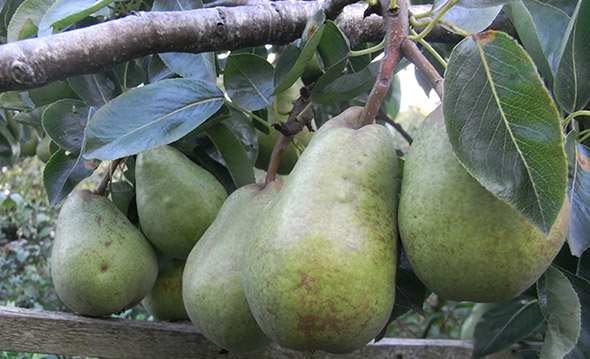
Ripe pears are juicier than apples and can be eaten raw or made into cider or a more traditional perry. They aren’t used much in cooking but there are still some delicious deserts that can be made with your crop (try peeling a really juicy pear and pouring warm chocolate over it, then cool it in the fridge. It’s a simple yet delicious dessert).
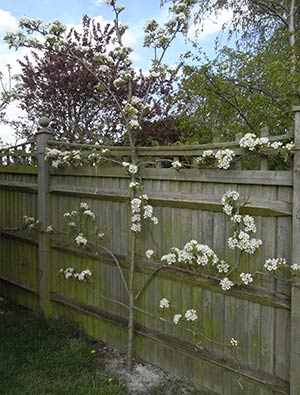
There aren’t as many pear orchards in the UK as there used to be. It is estimated that almost half of the pear orchards have been removed over the last 50 years. With the current popularity of pear cider, orchards are finally being replanted but it takes many years for producers to grow the trees to a sufficient size to produce a suitable crop. Standard pears trees can reach 16 metres tall which isn’t going to fit into the average garden! Thankfully a small espalier like I have planted can be productive within a year or two if it is purchased at a reasonable size in a pot. My trees were I admit already trained to a cane and 2-3 years old when I bought them but you can save money by buying a one year old tree and training it yourself.
The pear tree is in the same plant family as the apple: Maloideae and are usually grown on a Quince rootstock which produces smaller trees and induces earlier fruiting. As with other fruit trees, you must keep the graft above the level of the soil so that it doesn’t start rooting above the graft. Pears need chilling for 700-800 hours below 7⁰C to perform well. No real fear of that not happening in the United Kingdom!
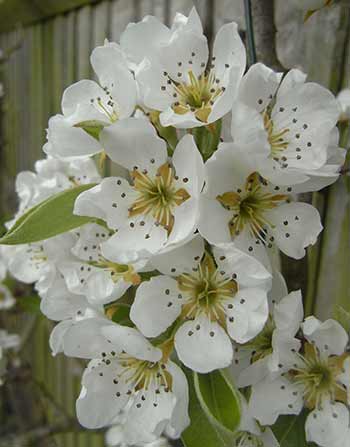
Pears flower earlier than apples (when I took the photos of my trees in flower, in early May, the leaves on the apple trees were barely unfolding). This is beneficial for the bees who are in need of food which is in short supply in the spring. The flowers are white, although some pear trees have flowers with a slight pink tinge.
When the tree is in flower, beware of frosts. A late frost will damage the blossom and you won’t have any fruit in the autumn. I keep a close eye on this and if there is a risk of frost, at the same time as I cover other tender / frost sensitive plants in the garden, I cover my pear trees with fleece which isn’t easy to do but ensures I get fruit in years when others don’t. Cross pollination is usually required unless you buy a self fertile variety (such as Concorde). Planting two trees that are in the same pollination group (are in flower at the same time) is sensible if you aren’t aware of other pear trees growing within a couple of miles.
There is normally a lot of fruit that develops on the tree. There should be a ‘June drop’ where the tree will shed some of this fruit naturally. If there is a heavy crop on the tree, you will get better fruit if you remove all but one fruit per cluster. If there isn’t too much fruit on the tree then this can be two fruits per cluster.
Pears trees in the UK will lose their leaves in the autumn (they are deciduous). Espaliers should be pruned in the summer and winter to to keep their shape and keep them productive.
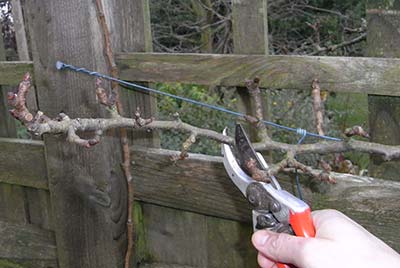
My espalier pear trees are winter pruned (between December and January) whilst dormant to remove lateral growth which results in vigorous new growth, and a stronger tree the following spring but also summer pruned (between July and August) to remove vertical growth which will restrict it but also create spurs for next year’s fruit. Pears will withstand harder pruning than apples once they have started fruiting.
Cultivated pears originate from a number of wild species that can be found across Europe and Asia. There are early and mid-season varieties available but here are some of the more common varieties I would recommend looking for:
- Conference – Possibly the most well-known of all varieties, a reliable cropper that also stores relatively well. More firm than other varieties.
- Williams – An early cropping pear, the Williams bon chrétien pear is widely grown in Europe. The skin turns yellow when ripe. They are called Bartletts in the U.S.
- Comice – Doyenné du Comice – Excellent flavour, and among the sweetest of the varieties of pear available. Undoubtedly the best dessert pear.
- Merton Pride – A very juicy pear with a yellowish flesh.
If you have the space then it’s well worth looking around for some more unusual varieties of pear. It’s always worth growing something you can’t buy in the supermarkets.
Decide what sort of pear tree you would like. Pears can be grown as espaliers against a fence or trellis or in orchards. Trees come in dwarf or standard sizes and is usually determined by the rootstock. Pear rootstock will mean big trees but Quince rootstock is fairly shallow routing, and as well as being suitable for growing on fairly heavy soils will produce a more compact dwarf size. If in doubt, check the label, you won’t want a full size tree in a small garden!
Plant pear trees in autumn (whilst the soil is still reasonably warm) or in the early winter at the latest in a sunny, sheltered position in well-drained, rich soil. This ensures trees can become established well before they come into fruit the next year. I mixed in a wheelbarrow-load of well rotted horse manure into the ground before planting although your own garden compost will also work well. We want the soil to be able to retain moisture, especially for pears on Quince rootstock. It is also important that pear trees can get sufficient Nitrogen so I always mulch around the trees in spring.
Full standards should be planted around 10m apart whilst dwarf varieties will need only 6m between them. Espaliers can be fairly close, mine are 3m apart. Don’t forget to support the tree with a stake and tree-tie and water it well during the first year in dry weather until it is established.
Pears can lose fruit to birds and wasps love pears so don’t leave fallen fruits on the floor as this will encourage them. Pears shouldn’t be left to ripen on the tree anyway so picking them as soon as the first few start to fall usually solves the wasp problem (see how to store pears below for proper storage and ripening). Rabbits will chew at the bark of trees in orchards but this is easily solved with a spiral tree guard around the base of the tree. Aphids can sometimes attack pear trees as will winter moth caterpillars. Pear leaf blister mites produce lumps in the leaves. Cancer is common, this is where the bark will start to split and crack. It is worth trimming back any branches affected when pruning.
If you’ve ever tried to store pears in the same way as apples, on slats or wrapped in newspaper in a cool dark place, you’ll soon find that they don’t tend to keep more than a few weeks or a month at best. There is however a way to store pears for 3-6 months and this is how the commercial growers store their pears for sale in the supermarkets.
The variety of pear is important, with the exception of Williams’ bon chrétien (known as Bartletts in the U.S.), winter pear varieties are the best for storing, varieties such as Anjou, Bosch, Comice or Winter Nelis.
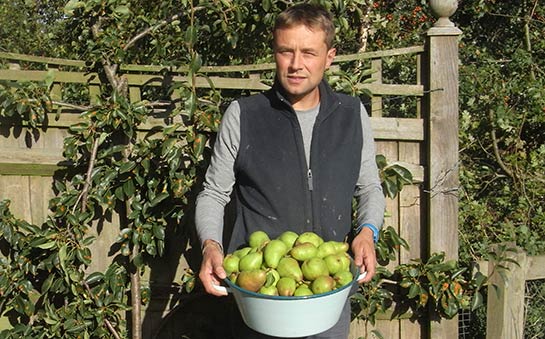
The secret to storing pears (and why the price increases in the shops as we get further away from the season) is to store them in a refrigerator. The optimum temperature is between 0 and -1⁰C but if you are using a space in your normal kitchen fridge then checking the temperature and turning it down a little can get pretty close and even a few degrees above freezing is pretty good. Most fridges will go below freezing but this spoils other vegetables and if you go below -1⁰C then the pears will spoil so be very careful with the final adjustments!
In case you’re worried about your pears freezing at this temperature, they don’t. This is because the sugar in the fruit acts like an antifreeze.
Humidity is also controlled in the storage of pears. The air is very moist with around 80 to 90% humidity. This is normally not too difficult to achieve in a household fridge – think of the condensation that is often seen on the cold back wall inside your fridge. Whilst this condensation is usually drained through a hole to the outside, removing it from inside the fridge, every time the door is opened, warm moisture laden air enters.
If you have a spare fridge and a reasonable amount of pears to store, this can be the best option. We used our caravan fridge for a few years. The caravan wasn’t used over the winter so we plugged it into the electric and kept it running until the spring and we had used up most of our stored pears. Now that we have sold our caravan, I use a small camping fridge in our garage. Even an electric cool box would be better than nothing.
How to store pears – Step by Step
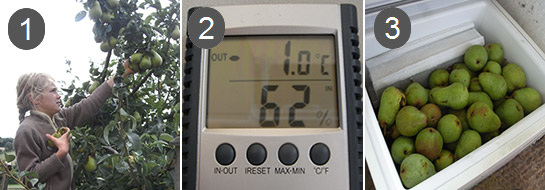
Pears are not difficult to store, but you will need a fridge and thermometer.
1
Pick your pears just before they are ripe, they should be firm. They will ripen up after storage when brought up to room temperature for a few days. Ripe pears will come off the tree easily, ideally, there should be a little bit of resistance to picking. I usually wait until a couple have ripened up (so a few have fallen off the tree) but most of the crop is still firm.
2
Prepare your storage area. Check the temperature is as close to 0 to -1⁰C using a thermometer. I bought a cheap thermometer / hygrometer from Amazon. It is better to be slightly on the high side than the low side, any colder than -1⁰C and you risk spoiling them. Pears do not freeze at this temperature since the sugars act like an antifreeze.
3
Pears can be placed onto shelves in a fridge, but will also store well in a salad draw or an open lid container. Once the minimum cold storage time has passed you can start removing them a week or so before you need them, allowing them to ripen at room temperature. The longer you leave pears in cold storage, the faster they will ripen up when removed.
To ripen properly, pears actually need time in cold storage. A couple of days is recommended for Williams and at least 3 weeks for other winter varieties so that they will ripen properly.
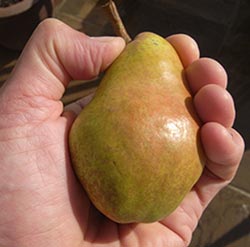
Most pear varieties do not ripen well on the tree. If you leave them to ripen until soft, they develop a coarse, texture and are often mushy by the time you reach the core. Pears picked under-ripe and chilled will ripen better than pears that are left to ripen on the tree.
Pears ripen from the inside so unlike some other fruits, you can’t tell if a pear is ripe by pressing it in the middle to see if it is soft, you will only be damaging the fruit. The neck (the end with the stalk / where it attaches to the tree) may be pressed lightly. If it yields to gentle pressure, the pear is ripe.
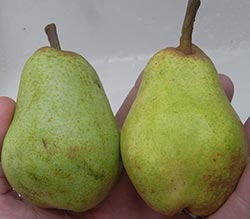
Do not press too hard though, it may still require more ripening.
Some varieties of pears such as Comice and Williams will change colour slightly as they ripen. The photograph shows two of my Comice pears, the one on the left is just-picked, ready for storage and isn’t ripe. The one on the right is softening and almost ripe. The skin is turning pale. It was picked 5 days ago and given another day or two will be perfect for eating.

what about storing cooking pears!
thx
They should be the same – a cold temperature such as a fridge will keep them longer..
I live in Pacifica, CA. My new house has a well established Bartlet Pear tree that is planted in the cement with a 31″ hole for it. How should I water and feed it?
I would probably try scattering pelleted organic manure (like Chicken manure) around the hole. This is high concentration but as it dissolves in water, by the time it reaches the roots, it should give the tree a good feed. The roots of course may reach out a long way outside of the concrete somewhere to get water and nutrients. If the tree is healthy now, it must be getting more than just rain water through the hole.
How can I find out what variety my pear tree is?
For years we have not used the pears because they are brick hard and tasteless and neither I nor my neighbour found a way to cook them that softened them. (The dogs love them and crunch their way through the autumn crop)Yesterday I I peeled and diced some pears, and with a little water in a bowl, microwaved them for four minutes. The result was a bowl of delicious stewed bears. It is a very old pear tree in a garden that was once an orchard. The house was built on the orchard land in 1890. I would like to pick and store the huge crop and have them to cook with in the winter.Please ccould you give me any advice?
A hard pear from my somewhat limited experience is probably being harvested too early; though pears should be quite firm on harvesting. There are a couple of measures of the correct time to harvest and I freely admit to getting it right only some of the time. The one I find most reliable is to lift and give a bit of a twist (pears generally hang down and lifting them to horizontal and adding a wee bit of twist, if they come off at the stem joint it is the right time). I live on the west coast of Canada and have none but Bartlett that I harvest as early as the end of August; though a variety called Clapp’s Favourite is supposed to be a week or two earlier (I don’t have them).
I am not expert at identification however I find a couple of sites helpful in trying to ID fruit. Some links are: https://www.orangepippin.com/ , http://www.fruitid.com/#main both of these say their pear pages are not ready for viewing but can still be helpful once you get into the site.
Hope this is helpful.
Very helpful comments as I have heavy cropping this 3rd year from a Lidl £4.95 pear tree. As an observation “meters” should be changed to “metres” (distance) on your website……the other spelling is for gas meters.
Thanks, I updated it.